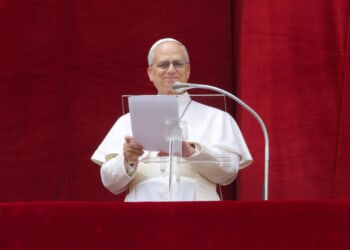
The CEO of aerospace company United Launch Alliance says that in a world dominated by hypersonic missiles, the U.S. must develop a layered defense system to ensure domestic security.
Tory Bruno, president and CEO of United Launch Alliance, told Threat Status this week that the U.S. is far behind China and Russia in hypersonic weaponry and will need to catch up rapidly if it hopes to compete globally.
“China is using their technologies to create space weaponry, which we are not doing. So in regard to that application, they are definitely pretty far ahead of us, and we’re playing catch up right now,” Mr. Bruno said in the latest episode of the Threat Status Influencer series. “In terms of the ballistic missile threat and the hypersonic threat, we, of course, have very sophisticated missile defense systems, the most effective ones in the world. But what’s changing is there are a lot more people with ballistic missiles now than there used to be.”
ULA is a launch services company founded as a joint venture between U.S. defense contractors Lockheed Martin and Boeing Defense. Over the past two decades, the company has emerged as one of the most prominent players in commercial space production. Last year, ULA launched its Vulcan Centaur rocket, a heavy-lift launch vehicle that provides an affordable alternative to SpaceX’s reusable rockets.
Traditional ballistic missiles follow a predictable high arc trajectory initially powered by rockets before allowing gravity to carry the payload to the target. Hypersonic missiles, conversely, reach much faster speeds of Mach 5 or higher and can maneuver mid-flight. Most of the U.S.’s missile defense systems are built to protect against traditional ballistic missiles, using interceptor rockets to destroy targets mid-flight.
Mr. Bruno explained that a hypersonic missile’s maneuverability could circumvent traditional missile defense systems.
“When we talk about this new hypersonic threat, we’re really talking about maneuvering hypersonics,” he added. “And so it’s the same kind of thing, except that that body doesn’t have to follow that ballistic trajectory. It waits till we commit our interceptor, and then it simply maneuvers out of the path, and we miss it. That’s the challenge.”
The U.S.’s possibly ill-equipped missile defense shield has captured headlines this year following President Trump’s promise to create a “Golden Dome for America.” Mr. Bruno said the U.S. has the technology to build and maintain the next-generation missile defense shield Mr. Trump wants and indicated several pre-existing systems that could be expanded to form a layered defense network.
He pointed to the Ground-Based Midcourse Defense system (GMD), which is comprised of two interceptor staging bases in Alaska and California. By applying the GMD system to other states, he said, the U.S. could have a better chance at defending against hypersonic threats.
“One of the key fundamental principles in missile defense is that you need a layered defense,” Mr. Bruno said. “When you’re defending your home, we wanna have more than one shot at this thing, and we wanna do it with systems that use different physics, to accomplish their mission so that the adversary can’t find the one thing that would get past the GMD, for example, and then count on being able to leak all the way through the target.”
In addition to GMD, Mr. Bruno says the U.S. could incorporate smaller-scale defense systems in high population density areas. The Terminal High Altitude Area Defense (THAAD) system is a missile defense system that can be used with the GMD system to create a stronger defense.
“The GMD system is designed to defend large areas of the U.S. from ICBM range threats, and it engages them only outside the atmosphere, which that kind of threat passes through on its way in. THAAD is a system that defends a smaller area,” he said. “States or multiple states in size, and it is able to engage a threat both outside the atmosphere, like the other systems, as well as in.”




![‘It’s a Recipe for a Hundred Years of National Dominance’: Stephen Miller [WATCH]](https://www.right2024.com/wp-content/uploads/2025/05/Stephen-Miller-Completely-Obliterates-CNN-Host-Over-Her-Illegal-Immigration-350x250.jpg)
![Trump Posts Hilarious Pope Meme, Leftists Immediately Melt Down [WATCH]](https://www.right2024.com/wp-content/uploads/2025/05/Trump-Posts-Hilarious-Pope-Meme-Leftists-Immediately-Melt-Down-WATCH-350x250.jpg)



![Mother Breaks Silence After Three Daughters Killed During Father’s Custody Visit, Memorial Held [WATCH]](https://www.right2024.com/wp-content/uploads/2025/06/Mother-Breaks-Silence-After-Three-Daughters-Killed-During-Fathers-Custody-350x250.jpg)

![Pentagon Begins Booting Trans Troops After Supreme Court Greenlights Ban [WATCH]](https://www.right2024.com/wp-content/uploads/2025/05/Pentagon-Begins-Booting-Trans-Troops-After-Supreme-Court-Greenlights-Ban-350x250.jpg)





